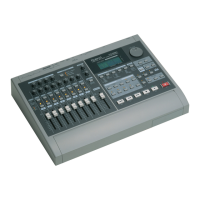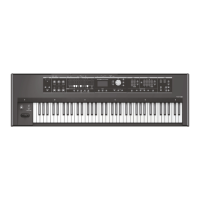16—Using Effects
222 www.Roland.com Roland VS-2000 Owner’s Manual
Each algorithm provides a set of parameters with which you can change the effect
processing it produces. To learn about each algorithm’s parameters, see the
VS-2000 Appendices
. When you edit a patch, you edit the values for the algorithm—or
algorithms—on which the patch is based.
It’s not uncommon for a patch to have more parameters than will
fit on one screen. When this is the case, you can navigate between
the patch’s screens by pressing F2 (NEXT) to move to the next
editing screen, or F1 (PREV) to move back.
All changes you make to a patch can be heard as soon as the next signal is sent into the
effect processor.
Editing an Effect Patch
To navigate to an effect’s first editing screen if you’re not already there:
1. Hold down SHIFT and press F3.
2. Press the processor’s F button to display its Algorithm View screen.
3. Press F3 (EDIT).
To edit an effect patch on any of its editing screens:
1. Select a parameter you want to edit.
2. Set its value as desired.
Effect and Direct Level Settings
Many effect patches offer FX Lvl (“effect level”) and DirLvl (“direct level”) parameters.
These two parameters are of special importance since they set the balance between wet
and dry signals. FX Lvl sets the level of the processed signal, while DirLvl sets the level
of the original signal. Both parameters have a range from -100 to 100, with 0 silencing
the effected or original signal, respectively.
If a patch is designed for use as a loop effect, it’ll be added to the dry input or track
channel signal in the MASTER mix or on tracks.Therefore, FX Lvl is typically set to 100,
the maximum volume, and DirLvl is set to 0.
With an insert effect, on the other hand, the effect’s output replaces the original signal,
so the FX Lvl and DirLvl values are more similar. While great care has been taken to
pre-program the right FX Lvl/DirLvl balance for each patch, you may wish to adjust
these settings for your project.
Preserving Patch Edits
There are two ways you can preserve an effect patch edit. You can:
•Save your current mixer settings—including your effect settings—as a scene, as
described in “Scenes” on Page 142.
•Save your effect patch edits as a new user patch, as described in the next section.
VS2000OMUS.book 222 ページ 2004年10月20日 水曜日 午後3時3分

